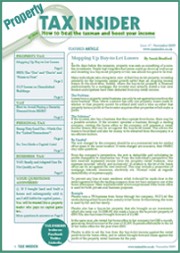Before you go, sign up to our free tax saving email course. Get 7 top property tax saving strategies in your email inbox that will help you save thousands in tax. Unsubscribe any time.
|
Linked transactions The SDLT legislation includes a provision (FA 2003, s 108) to prevent avoidance of SDLT by artificially fragmenting transactions to get below the SDLT threshold: Example 1: Separate purchase of house and garden Mr and Mrs Crafty are buying a house from Mr Wiseguy. The price is £255,000, so 3% SDLT will be payable. The Craftys agree with Wiseguy that Mr Crafty will buy the house for £230,000 (meaning SDLT at 1%, a saving of £5,350) and Mrs C will buy the garden for £25,000 (no SDLT as it is below the threshold of £125,000). Unfortunately, the rules for ‘linked’ transactions apply. Transactions are ‘linked’ where they ‘form part of a single scheme, arrangement or series of transactions between the same vendor and purchaser or, in either case, persons connected with them’. This means that the payments by Mr and Mrs Crafty are added together for the purpose of arriving at the rate of SDLT to be charged, so they will both have to pay 3% on their purchases. Like most anti-avoidance legislation, these rules caught transactions where there was no intention to avoid SDLT, and sometimes produced unfair results. The commonest example was buy-to-let investors buying more than one property from the same seller – for example from a property developer. The rules meant that the rate of SDLT could be unfairly high in such circumstances – buy three ‘off plan’ flats for £170,000 each from a developer and the SDLT rate was a whopping 4% because the ‘linked’ price of £521,000 broke the £500,000 threshold. Multiple dwellings relief The problem was solved by Finance Act 2011, which introduced relief for purchases of ‘multiple dwellings’ (FA 2003, Sch 6B). For transactions after 19 July 2011 (and not ‘linked’ to earlier transactions), the rate of SDLT on a purchase of more than one ‘dwelling’ between the same buyer and seller is determined by the average price per dwelling. This applies to purchases that are part of the same single transaction, or part of a series of ‘linked’ transactions. For example, if you buy a house divided into two flats for £350,000, the rate of SDLT payable is not 3% (as it would be if the building was not divided into flats), but 1% because the average per flat is only £175,000. Note that if you buy this property for £240,000, the rate of SDLT will be 1%, even though the average price is £120,000, which is below the threshold for SDLT. The minimum rate you can achieve with the relief is 1%. Example 2: Converting a house into flat Mr Wiseguy has had another idea. How about if he converts his house into two flats? That will achieve a 1% rate for the Craftys, because the average price per flat will be £175,000. Leaving aside the cost of making a convincing job of the conversion, this ruse is also not going to work, because if the Craftys convert the flats back to one dwelling within three years, they will have to pay the additional SDLT that would have been due if they had bought one dwelling. Although Mr Wiseguy’s tax planning skills are somewhat limited, there is one situation (below) where his idea could work. Practical Tip: If you are buying a house you intend to convert into two or more flats, it may be possible to reduce the rate of SDLT by agreeing with the seller that he will start the conversion before the sale - with the purchase price increased to cover his costs. The relief also applies where a property is ‘in the process of being constructed or adapted for such use’. Take advice, though – this can be complicated. This is a sample article from the monthly Property Tax Insider magazine. Go here to get your first free issue of Property Tax Insider. |


 Tax Articles
Tax Articles
 The stamp duty land tax (SDLT) legislation provides a special relief that applies where multiple residential properties are bought as part of the same deal (or ‘linked’ deals).
The stamp duty land tax (SDLT) legislation provides a special relief that applies where multiple residential properties are bought as part of the same deal (or ‘linked’ deals).